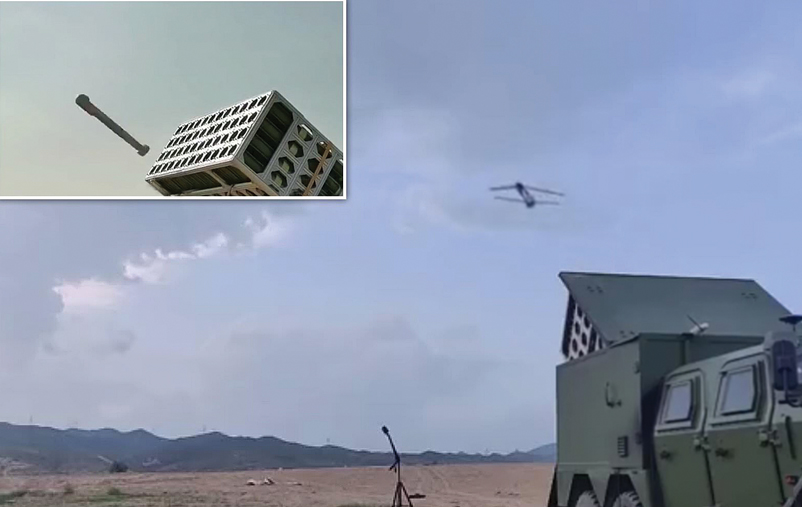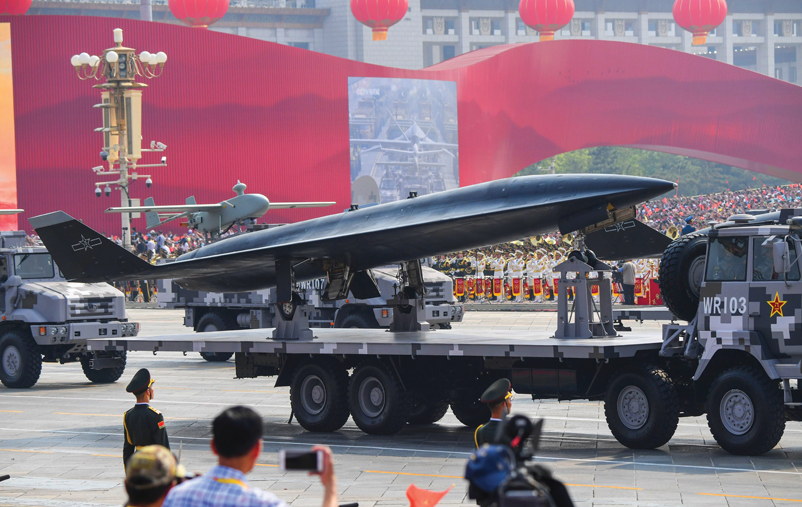Both the United States and China have sought to employ drones for a wide range of military operations, whether for reconnaissance and surveillance or combat purposes, as part of their plans to enhance their military capabilities and prepare for potential future battles. The efforts of both countries in this regard have shown significant similarities. The following analysis sheds light on the different plans of the United States and China to employ drones in future combat operations.
The American Concept of Air Dominance
Reviewing the abundant research and intellectual websites, as well as specialized platforms covering military news, highlights the prominent uses of drones in combat operations as follows:
1- Employing 6th Generation Fighter as a Mothership: The US Air Force said that its future plans are based on a virtual fleet consisting of approximately 1,000 advanced autonomous drones with high degrees of autonomy, along with 200 next-generation stealth fighters for air dominance.
Synchronization is expected between the 5th generation F-35 fighters and these advanced drones.
However, future plans for the concept of the 6th generation fighters rely on building fighters with longer ranges and the ability to carry a larger weapons payload to reflect the current geopolitical realities of any potential Sino-American conflict in the Western Pacific.
Code-named “Next Generation Air Dominance”, Washington is developing its 6th generation fighter with capabilities that include employing artificial intelligence in flight operations, controlling drones that will accompany the 6th generation mothership, as well as having the ability to communicate with friendly forces’ sensors in a manner that surpasses the capabilities of the American F-35 fighter, which already can communicate with this sensor network. There are also plans for the new fighters to possess powerful engines capable of flying at supersonic speeds, as well as generating enough electricity to operate powerful electronic warfare devices in the fighter or laser-directed energy weapons.
Moreover, fighters are expected to connect to ground platforms, as such a fighter will serve as the “mother of systems.”

2- Employing Networked Swarm Drones: The United States was the first country to practically use swarm drones in 2016 when three F-18 aircraft launched around 103 drones over a target.
These drones were designed by students from the Massachusetts Institute of Technology, with wings measuring 12 inches long, functioning as a “collective living organism.” On the computer screen, they appeared as small green dots moving to surround the target. In 2020, the U.S. Air Force conducted a simulation in collaboration with the RAND Corporation to measure the effectiveness of swarm drones in defending Taiwan against potential attacks from China.
The swarm drones utilize a laser-based data exchange network, providing them with a high degree of autonomy and instant information sharing.
The United States plans to employ networked swarm drones to overcome anti-access/area-denial tactics that China may deploy around Taiwan to prevent U.S. intervention in the defence of the island. These Chinese capabilities include ballistic and cruise missiles, anti-satellite weapons, integrated air defence networks, and fifth-generation fighter aircraft. The U.S. military can deploy these drones from stealthy fifth-generation fighter jets like the F-35 or F-22 to strike Chinese warships, aircraft, and missile batteries. Additionally, drones can be used as screens for fighter jets, expanding their capabilities for reconnaissance and intelligence gathering without revealing the presence of stealth fighters.
These drones will achieve two goals simultaneously: increasing situational awareness and enhancing target acquisition capabilities for U.S. fighters while overwhelming enemy radar screens with multiple targets, forcing them to waste limited missiles and ammunition on these drones before the American fighters carry out their attacks. These drones will employ machine learning and artificial intelligence, allowing swarm drones to view targets from multiple angles, verify targeting data from different drones, and suggest the best approach to attack a specific target.
3- Enhancing the Effectiveness of Conventional Weapons: The U.S. Army researched using drones to provide cost-effective alternatives for long-range missiles. Military programs like “Skyborg” aim to build drones capable of jamming or disrupting air defences and accurately guiding missiles to cause maximum damage.
Military analysts believe that employing drones will become highly significant in the future to compensate for the Western military-industrial complex’s shortfall in producing complex equipment, weapons, and missiles, a gap that became evident in the recent Western support for Ukraine in its war against Russia, which prompted the need for drones that can be easily produced.
Similarly, Russia is currently using drones in its ongoing war against Ukraine, alongside ballistic and cruise missiles. Through this approach, Russia aims to exhaust Ukrainian air defence systems and ensure its ability to hit intended targets, even if Ukraine manages to intercept some of the incoming missiles.
Chinese Drones Program
Many officers in the Chinese People’s Liberation Army Air Force and other Chinese analysts emphasize the need for China to continue developing drones for a wide range of missions.
For example, both Huang Sujian and Zhang Zhenbing emphasize the need for the Chinese air force to develop “autonomous, stealth, and computationally optimized” combat platforms.
Furthermore, Chinese analysts have published numerous research papers on drones, and many Chinese defence industry institutions are also involved in this research.
The Chinese government is conducting extensive research on the future uses of drones for a wide range of operations, which can be detailed as follows:
1- The 6th- generation mothership: On January 31, 2023, the Chinese aviation industry institution released a video showcasing the concept of the sixth-generation Chinese stealth fighter.
The Chinese jet fighter had twin engines and radar-absorbent wings, in addition, it was diamond-shaped and tailless. However, such models may never see the light of day, like Lockheed Martin’s X-44 MANTA, which remained only a concept and was never manufactured.
Although, China’s construction of a tailless sixth-generation fighter similar to its American counterpart indicates that it might build it using the same technologies used by the United States.
The video published by China showcasing the sixth-generation fighter in January 2023 resembles the Chinese fifth-generation stealth fighter J-20, which led military analysts to believe that it will serve as the basis for the development of the sixth-generation fighter.
Furthermore, it is believed that the Chinese sixth-generation fighter will include other advantages, such as the ability to control other drones, as well as the use of directed energy weapons, which China is currently developing for the J-20 fighter, so it is likely that they will also be employed in the sixth-generation fighter.
A recent simulation of China’s attempted invasion of Taiwan in 2026 conducted by the Center for Strategic and International Studies revealed that American bombers launching missiles hundreds of miles east of the island could inflict significant damage on the Chinese People’s Liberation Army Navy.
Therefore, it is likely that the People’s Liberation Army Air Force would want long-range stealth fighters capable of penetrating air defences and engaging fighters near Taiwan to attack American bombers launching long-range missiles from behind.
At the same time, the U.S. Air Force wants its sixth-generation fighter to have the ability to fly over 1,000 nautical miles to accompany American bombers launching attacks on China from bases beyond the reach of most of China’s precision ballistic missiles.
Thus, both air forces seem to be seeking to possess a sixth-generation fighter with similar concepts and the ability to control drones.

2- Chinese Drone Swarms: China has mastered the use of hundreds of civilian drones in a musical performance, using over 1,300 drones in a light show to break the world record in May 2018 in the city of Xi’an.
Later, China presented unusual displays of drones flying in formations that resembled a medical team, illuminating the skies of Chongqing to commemorate healthcare workers during the COVID-19 pandemic.
The Chinese Academy of Electronics and Information Technology conducted its first test of military drones in June 2017, involving nearly 120 fixed-wing small drones.
Four months later, the company conducted its largest test using 200 fixed-wing drones. The most significant experiment came in September 2020 when around 48 drones were launched from trucks and helicopters, and the same drones could be launched from maritime platforms.
This experiment revealed China’s ability to deploy swarms from multiple platforms and attack a targeted area from different directions to destroy it.
Such a threat will be significant due to the absence of air defence systems capable of effectively targeting these systems, especially since most laser-based air defence systems are still under development.
The incident of Chinese spy balloons above the United States not only revealed the risks of espionage using this method, but also the possibility of China’s deployment of drones on these balloons for espionage, reconnaissance, and surveillance purposes.
Researchers from China and other countries have been publicly researching this for years.
3- Hypersonic Drone Development: Leaked Pentagon files published on April 19, 2023, revealed that the Chinese People’s Liberation Army “almost certainly” operated the world’s first hypersonic drone known as the WZ-8.
According to the Pentagon files, the drone was deployed in the western Anhui province under the command of the People’s Liberation Army, making it ready to intervene in the potential main conflict points between the People’s Liberation Army and the United States, whether in Taiwan or North Korea.
According to US assessments, these drones can be deployed using the H-6M aircraft.
It is still uncertain whether they are capable of performing long-range missions, such as over the disputed Diaoyu/Senkaku Islands. The hypersonic drone WZ-8 is the first of its kind in the world.
Washington fears that the Chinese drone will enhance the Chinese military’s capability to gather massive intelligence information, for which China relies on other methods, such as the Chinese satellite network, in addition to numerous advanced reconnaissance drones.
Moreover, the hypersonic reconnaissance drone is currently under development in the United States but has not yet been produced.
4- Domestic Surveillance Purposes: Drones are used in China to monitor border areas like Xinjiang, while the central government uses facial recognition technology to scan individuals visiting tourist sites and compare them to a centralized criminal database called “Sky Net”, especially in areas where the Muslim Uighur minority lives.
Chinese police use a range of biometric data and other means, such as GPS tracking devices in vehicles and government-installed programs on mobile phones, to track individuals who may be considered suspicious.
Citizens are given a digital rating indicating whether they are considered safe or suspicious. In 2017, China deployed around 1,000 drones for tasks such as tracking suspects for law enforcement, monitoring traffic, and locating opium farms.
Conclusion
The United States and China are developing various types of drones for reconnaissance and attack purposes, for use in their future wars. The similarity in drone usage between the two countries is due to each country’s surveillance of the other, especially regarding drone production. Additionally, both countries anticipate the possibility of a conflict in Southeast Asia over Taiwan. Despite the anticipated uses of drones in future wars, their effectiveness will only be confirmed under conditions that simulate real warfare, especially considering that Washington and Beijing have nearly identical plans for the use of drones.
» By: Dr Shadi Abdulwahab (Military and Strategic Researcher)













